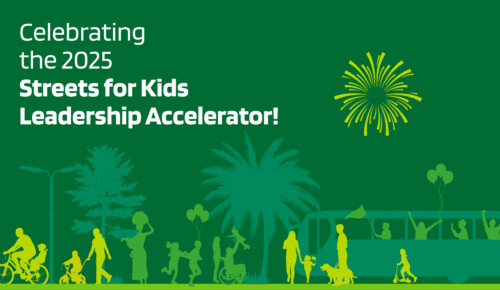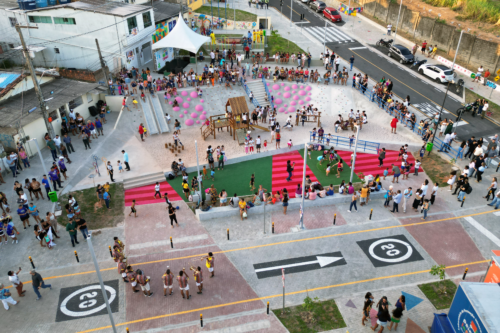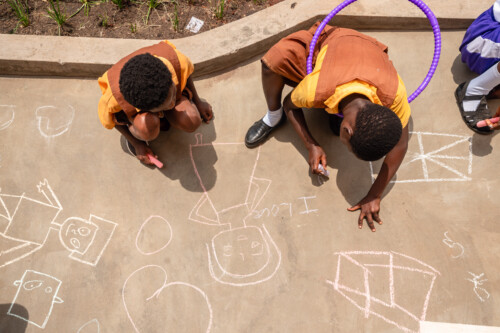The Bloomberg Initiative for Cycling Infrastructure (BICI) is a competitive grant program that will foster catalytic change in city cycling infrastructure around the world. Cities will be able to submit an application to this opportunity started November 10, 2022.
BICI will select and award funding and technical assistance to 10 cities to accelerate the delivery and expansion of cycling infrastructure. The opportunity is designed primarily for cities with more than 100,000 residents, and will take place over three years.
We want to help your city submit a strong application to BICI. In early November, we held informational webinars where we answered questions about the program and how to apply. Answers to some of the most frequently asked questions about BICI are below.
Have more questions that aren’t answered here? You can also watch the recorded webinars or contact the BICI team at bici@gdci.global.
Eligibility
1. What cities are eligible for the BICI Program? Any city, town, metropolitan authority or other local government authority with a population of 100,000 or more (within administrative limits) is eligible for the BICI Program; there is no maximum cut-off. Competitive applicants will have an existing staff structure and capacity to deliver streetscape improvement projects and may have experience installing cycling infrastructure. If you are curious about your eligibility, email bici@gdci.global.
Aggregations of cities, towns, metropolitan authorities or other local government authorities are also allowed to apply (within the same metropolitan area). However, we expect one authority to take the lead on the application.
There is no limit to the number of cities that can apply from within a single country.
2. What kinds of activities will the BICI Program fund? The BICI Program is focused on accelerating the implementation of cycling infrastructure, so eligible expenses must contribute directly to this work. BICI will celebrate and support cities that:
- Dramatically re-imagine infrastructure to reclaim and repurpose existing space, or create new facilities that put cyclists first,
- Create complete networks that allow people of all ages and abilities to cycle safely and conveniently,
- Show what’s possible by bringing world-class cycling infrastructure to regions that currently lack it
- Experiment with new materials, technology, or implementation methods in ways that make cycling networks easier to build or encourages more people to ride,
- Centers people above all else by taking into consideration the risks, choices, and tradeoffs residents face when deciding how to travel through their cities.
The most successful proposals will feature projects that accomplish one or more of these goals, while bringing together government agencies, community members and resources in new ways, and that are combined with new city policies that ensure cycling infrastructure improvements are implemented at scale.
We expect BICI grant funds will typically support the purchase of products and materials used to create, deliver, and evaluate safe cycle infrastructure. The majority of funds should be used to directly support the expansion or completion of cycle infrastructure. However we will also consider funding other supportive cycling facilities, such as cycle parking, cycle path lighting, cycle-hire equipment, and equipment used for metrics collection. Part of the funds can also be used to fund elements of cycleshare projects. Consulting and/or staff support will be considered on a case-by-case basis.
3. What activities are NOT eligible to receive BICI Program funding? The BICI program will not fund political or lobbying activities, classes or education, the purchase of bicycles for businesses or individuals, or any other expenses or activities not directly related to the installation of cycle infrastructure. Grant funding should primarily go towards direct project implementation.
4. How will the funding be made available? Funds will be delivered in the form of a grant, which can be made directly to city governments. As this can sometimes take time administratively, it is also possible for the payment to be made to a local third party that is in direct partnership with the city, such as an NGO. Funding will be based on a performance or milestone-based agreement. The milestones and scheduling of payments will be discussed with the city, to meet their individual needs. The financial support will be available until March 2026.
5. Does the application require a local match? A specific level of local match is not required. However, because of the ambition and scale of cycling infrastructure projects, we expect the strongest BICI applications will include additional resources of some kind. These could be municipal funds, state or federal grants, in-kind support, or other philanthropic funds.
Program
6. What will my city receive if selected for BICI? Ten selected cities will accelerate the delivery of ambitious cycling infrastructure projects with the help of:
- Grant funding: Nine selected cities will receive up to $400,000 USD in direct funding to support the delivery of its local projects. One grand prize city will be selected to receive $1,000,000 USD in funding.
- World-class technical assistance from the Global Designing Cities Initiative (GDCI): Selected cities will be paired with technical experts from the BICI team who will provide technical assistance through the duration of the program. Experts from GDCI will provide:
- Capacity Building Sessions: The BICI Program will host capacity building and peer sharing sessions to help bring BICI projects to life. The content will be based on the award-winning Global Street Design Guide which has been formally endorsed by mayors around the world. This will include regular sessions customized for local context and needs.
- Project Design Review and Implementation Support: Throughout the program, technical experts on the BICI team will provide in-depth technical review, guidance, and recommendations to specific projects and designs in close coordination with city staff. In addition, the BICI team will provide guidance and support during project implementation including implementation techniques, messaging, community outreach, and metrics.
- BICI Cities Network: The ten cities will be part of a BICI Cities Network of leading cycling cities. Opportunities include peer-to-peer exchanges, study tours, and access to leaders in designing and building cycle networks. As program participants, a delegation from each city will be invited to attend three global gatherings (two in-person, one virtual) in addition to regular online sessions to facilitate peer learning and global exchange of best practices. The first gathering will be held in Summer 2023. The host city will be announced at a later date.
- Showcase your work: Cities will be spotlighted through Bloomberg Philanthropies and GDCI’s networks, case studies, media coverage, and featured speaking opportunities at international conferences.
7. What is the BICI Program duration and timeline?
- Application period opens: November 10, 2022
- Application period closed: February 3, 2023
- Announcement of selected cities: Spring 2023
- BICI projects begin: Summer 2023
- Program support finishes: March 2026
8. Is this program designed to develop new proposals? Or can we participate with existing projects? The program can cover both scenarios. Maybe you have projects ready to go and you were just waiting for funding, in which case we can help with that! Conversely, if you have an idea for an innovative, ambitious project designed to significantly improve cycling infrastructure in your city, we’d welcome an application from you. In either scenario, please ensure your application conveys the vision of these projects and what you hope to achieve within the duration of the grant program. Please see the types of project we are looking to support under question 2.
9. What will be expected of selected cities? Participation in BICI includes specific requirements, including ongoing collaboration and communication with BICI staff, monthly reporting, and occasional travel to participate in workshops and other events. In addition to implementing the city’s BICI project, selected cities are expected to:
- Identify two lead staff members (one primary, one backup) who will be the primary points of contact for BICI Program activities
- Join regular video meetings with other participating cities to share news, best practices, and challenges with the BICI team
- Participate in three annual global gatherings in 2023, 2024 and 2025 (two will be in-person events, one will be virtual)
- Provide regular updates on project progress including challenges and resource needs
- Ensure that leadership and staff are available for external and internal media requests related to the BICI Program participation and outcomes
- Provide a final breakdown of the funds used, a narrative report, data collection and metrics, and photo/video documentation of project delivery to close out the award.
Participating cities are expected to dedicate staff to fulfill the requirements of the BICI Program and to implement their infrastructure plans. The specific time and resources required will vary from city to city. BICI Program requirements (cohort calls, program check-ins, technical meetings, reporting and other activities) will average 8-10 hours/month, in addition to the time spent implementing the city’s BICI project.
10. Will there be further rounds of grants in upcoming years? At this time, we cannot say with certainty, but our objective is to take the successes of this program and learn from them to be able to scale for future programs and impact. However, if you feel like your city is a potential strong fit for this opportunity, we’d encourage you to apply during this round!
11. What language requirements are necessary to participate? We will require applications to be submitted in English and we expect that the primary points of contact have fluency in English to coordinate both with the GDCI team and to communicate with other program participants. However, the program will fund translation and interpretation services to ensure technical guidance, training, and other program content can be disseminated to as many local participants as possible.
Application
12. How can I apply for the BICI program? Applications and all supporting documents must be submitted using BICI’s online submission portal which will be available at https://bloombergcities.jhu.edu/bici starting on November 10, 2022. The application is a combination of data entry, written responses, and a letter of support from the relevant city leader. Applicants were able to upload supporting documentation through the online portal from November 10, 2022 until February 3, 2023. The applications closed on Friday February 3, 2023. at 11:59pm Eastern Standard Time (New York). A fee was not required to apply.
Please note:
- Applications may only be submitted through the online portal. Emailed, mailed or faxed applications will not be accepted.
- Submissions must be made in English.
13. Where can I find additional information about the BICI Program? Program details, including a printable version (in English, Portuguese, Spanish, French, Hindi, Arabic, Mandarin) of the application and updates can be found at https://bloombergcities.jhu.edu/bici.
14. Who do I contact with additional questions about the program, application, or process? Please contact us at bici@gdci.global and we will follow-up directly on specific questions.
15. Who should be the Lead Applicant on the application? The Lead Applicant should be the city, town, metropolitan authority or other local government authority that has jurisdiction where the proposed projects are located. The Primary Contact should be the official agent or representative of the Lead Applicant.
16. Can local place-based organizations, universities, or NGOs apply? Only government entities may apply. Locally based organizations including NGOs, private sector consultants, businesses, community groups, other agencies and individuals are not eligible to apply. However, we do encourage their participation in the program in conjunction with government entities when relevant.
If your organization is officially designated as a representative of a local government authority, please contact bici@gdci.global to determine eligibility.
17. Will the application require a budget? Yes, cities are expected to submit a budget using BICI’s budget template. The budget will need to be for the full project amount, with $400,000 being sourced from BICI.
18. Will selected cities be expected to cover travel costs related to the BICI global gatherings in their grant application budget? No. The BICI team will cover all travel related expenses for trips that the program requires.
Selection
19. How will cities be selected? Each application will go through a rigorous review process from the BICI team and external advisors. The selection committee will evaluate each application based on the city’s vision, goals and impact for implementing high-quality cycle infrastructure, resources committed to that implementation, existing local capacity, commitment, community engagement and support, financial investment, and potential impact.
20. What type of cycling infrastructure is the program funding? The baseline expectation is that the cycling infrastructure proposed allows for what we call all ages and abilities cycling, that is inclusive, safe and provides high levels of comfort/low levels of stress. For design guidance, inspiration, examples and international best practices, please reference GDCI publications, such as the Global Street Design Guide or the Designing Streets for Kids publication. Both publications provide guidance around infrastructure design and network design for cities all around the world. In addition, we welcome new ideas and innovations with respect to cycling infrastructure that have the opportunity to set new standards and precedents for cities within the region and beyond.


